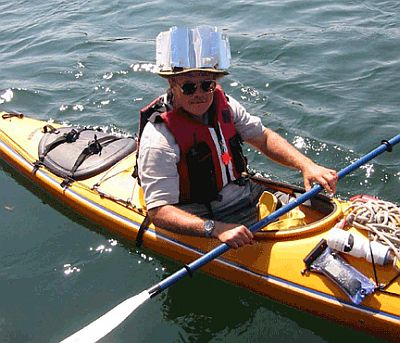In fog a seakayak is the most vulnerable craft out at sea you can think of.
You have to use all your skills and experience when you have to cross a shipping-lane. Better would be to prevent a foggy-crossing like that.
However when it might be necessary to make such a crossing once, be aware that you depend completely on the radar aboard ships AND the crew which is supposed to keep an eye on the radar.
Your ears are not allways of great help as some ships glide silently through the fog and are close before you notice.
As a kayak is a very low profile vessel, the visibility on a radar is not overwhelming. In the past quite a lot of investigations have been done and what I recall from that is that a choppy sea can make a kayak almost invisible as you are most of the time in between the waves. Even a radar-reflector is not considered as the ultimate solution.
Yet I found on internet that in 2004 an extensive visibility study has been carried out by also "the Maine Association of Sea Kayak Guides and Instructors", "Maine Sea Grant (university)" and "US Coast Guard".
A thorough research went throug different types and sizes of seakayaks, as well quite a lot of radar-reflectors (commercial- and home-made versions)
Their conclusions were not a surprise to me:
- Choose and mount your reflector wisely.
- The greater the angularity of a radar reflector, the greater its visibility factor.
- The larger the kayak the greater its visibility factor.
- Kayaks paddling closely together in a pod formation produce a much more significant radar return than a kayak paddling singly with a radar reflector.
- At both 1/8 and 1/4 nautical mile, kayaks consistently showed up on radar.
- The angle of the sea kayak to the radar platform affects visibility.
- The visibility factor decreases with distance away from the radar platform.
- The higher the radar antenna is mounted, the less effect sea state has on kayak visibility.
- Radar is only effective when it is being watched.
Also the recommendations for Paddlers seam practical to me, but were not a real surprise:
- Some form of radar reflector is better than none
- Radar reflector design needs to be functional for paddling
- Mount reflectors to generate the greatest return, consider both height and orientation
- Travel in tight pods to provide a greater radar return
- Plan crossings for narrow channels and known navigation references. Make securite calls on VHF 16 and local channel to advise crossing underway. Specify exact points of crossing.
However an eye-opener to me was the "aluminium hat",a home-made reflector, that performed much better than the rest.

As the head is the highest point of a paddler the result is logical, but since a "radar-reflector-hat" has not been seen before, I would like to share this information with you.
If you want to read more about this study you can follow this link: [www.seagrant.umaine.edu]
